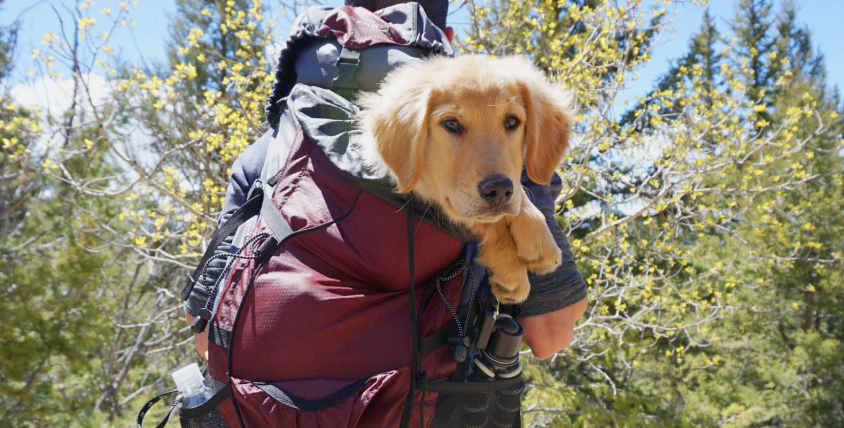Hiking? Protect Your Dog in All Seasons
Taking your dog on a hike is one of the best ways to bond while exploring the great outdoors. Here’s an updated SENDY guide to keeping your pup protected and happy on any adventure!

Proper Identification: a well-secured collar with an ID tag displaying your current contact information is a must. For extra security, consider having your dog microchipped and ensuring the contact details are up to date. Attaching a GPS tracker to the collar can provide peace of mind, especially in remote areas.
Pre-Hike Health Check: before hitting the trail, be sure vaccinations are current, and discuss parasite prevention, including flea, tick, and heartworm medication, with your vet. Mention the region you plan to hike in—some areas have unique risks, like rattlesnakes or certain tick-borne illnesses. If you think your dog was exposed to contaminated water or feces, Giardia can be tested for after the trip
Tick, Flea, and Parasite Prevention: use vet-recommended preventatives year-round. After every hike, thoroughly check your dog for ticks, particularly in hidden areas like under the ears, around the neck, and between paw pads. A fine-toothed comb and tick removal tool can help.
Seasonal Grooming: adjust grooming to suit the weather. In summer, keep your dog's coat trimmed to prevent overheating, but avoid shaving double-coated breeds entirely—they rely on their coat for insulation and protection from sunburn. In winter, longer fur can help with warmth, but ensure it’s brushed regularly to prevent matting and ice accumulation.
Paw Protection: your dog’s paws endure a lot on hikes. Hot pavement, ice, gravel and sharp vegetation can all cause damage. Protect them with dog booties, paw wax, or both. Train your dog to wear booties before the hike as they take some getting used to. In winter, rinse paws after hikes to remove salt or ice-melt chemicals because they can irritate the skin.

Hydration is Key: carry plenty of water for you and your dog, especially in hot weather or on longer hikes. A collapsible or portable dog bowl makes hydrating on the go easy. Avoid letting your dog drink from stagnant water, which can harbor harmful bacteria or parasites like Giardia.
Trail Nutrition: hiking burns calories! Pack nutrient-dense snacks for your dog, like treats designed for active pups. Ensure their diet (calories) aligns with increased activity levels. Of course, bring more food for multi-day hikes, packed in airtight containers to keep it fresh.
Weather-Appropriate Gear: equip your dog with the right gear for the season. A winter jacket or insulated vest will protect against cold temperatures, while a cooling vest or bandana helps in hot weather. Doggy backpacks can help distribute the load if your pup is fit enough to carry their own essentials.

First Aid Kit: include items tailored to your dog, i.e., any medications:
Also, bandages and gauze for wounds, antiseptic wipes or sprays that are safe for dogs, tweezers or tick removal tools, styptic powder for minor bleeding, and spare booties in case one gets lost.
Take Breaks and Watch for Fatigue: some dogs push themselves beyond their limits, so it’s up to you to monitor their energy and hydration levels. Look for signs of overheating, like excessive panting or drooling, or cold stress, like shivering. Stop often for water, snacks, and rest.

Leash Up and Follow Etiquette: even if your dog is well-trained, some trails require leashes to protect wildlife, other hikers, and your pup. Keep them close in areas with steep drop-offs, wildlife, or heavy trail traffic.
Prepare for Sudden Weather Changes: since Mother Nature is unpredictable, pack a lightweight, waterproof dog jacket or poncho for rain and a small towel for drying off. A compact, foldable tarp can also provide emergency shelter.
Dog-Safe Insect Repellent: avoid repellents containing DEET, as it can be toxic to dogs. Opt for pet-safe products to protect against mosquitoes, flies, and other biting insects.
Wildlife Safety: keep your dog away from wildlife to avoid dangerous encounters. A bear bell or noise-making collar attachment can help alert animals of your presence, reducing the likelihood of a surprise encounter. Always keep your dog under control, especially if wildlife is spotted.
Trail Knowledge: research trails beforehand to ensure they’re dog-friendly and free of hazards like jagged rocks, narrow paths, or intense inclines. Know where water sources are along the route, but bring extra water in case streams are dry.
Train for Safety: basic obedience is crucial in unpredictable outdoor environments. Ensure your dog reliably responds to commands like “come,” “leave it,” and “stay.” Training sessions on short trails can help reinforce good behavior.
Emergency Preparedness: know where the nearest veterinary clinic or pet-friendly emergency services are located. For multi-day hikes, pack a sling in case your dog gets injured and needs to be carried.

Follow these SENDY recommendations to protect your dog in every season and make your outings more fun!